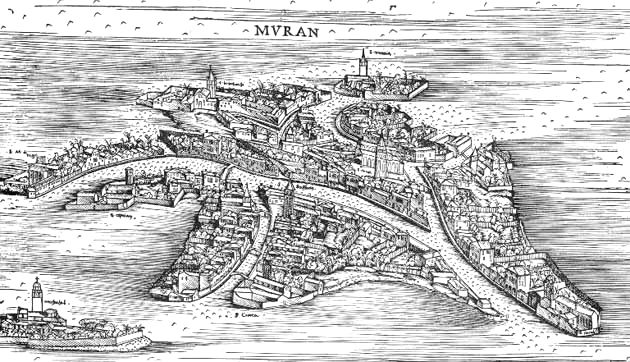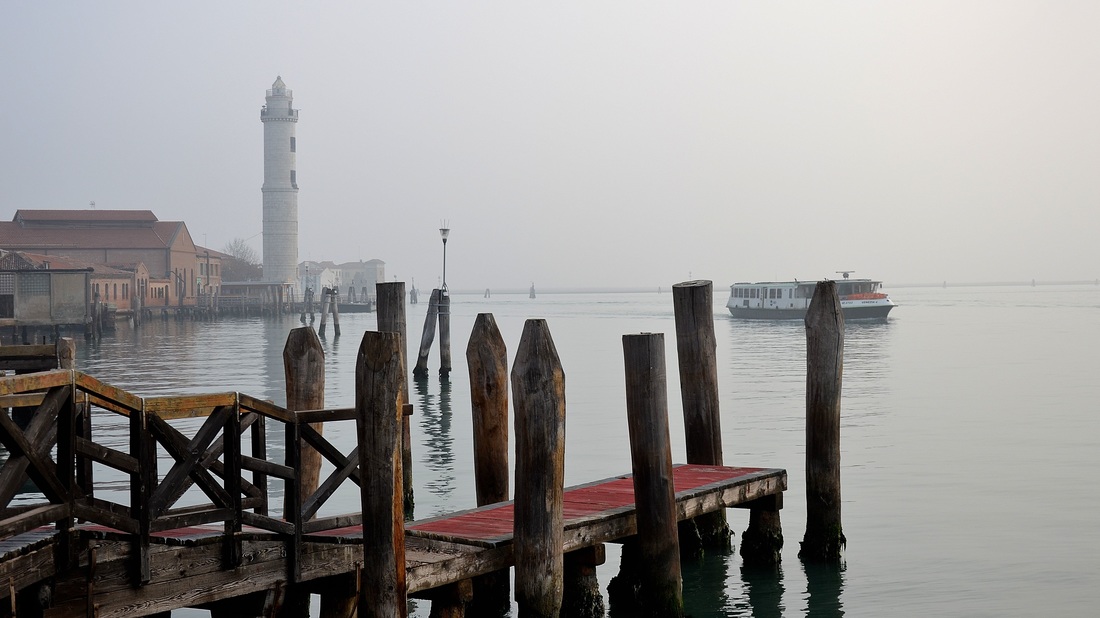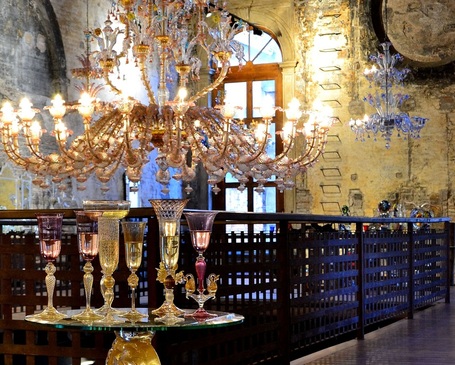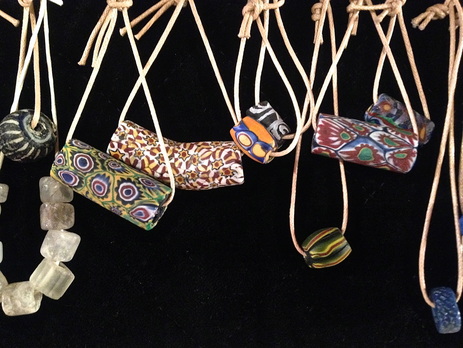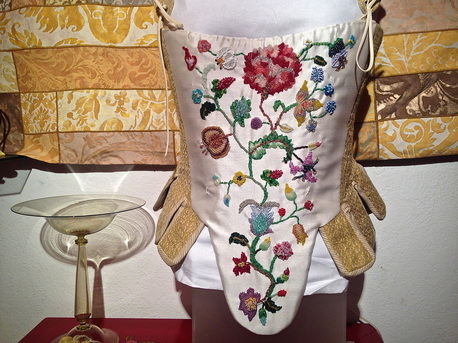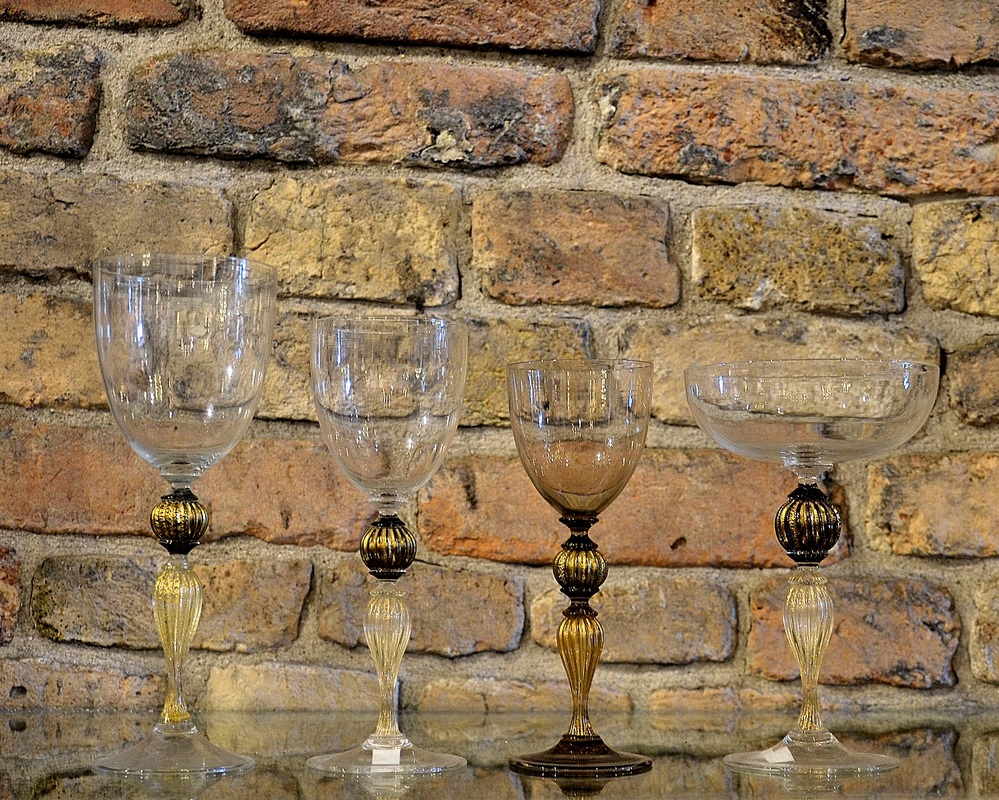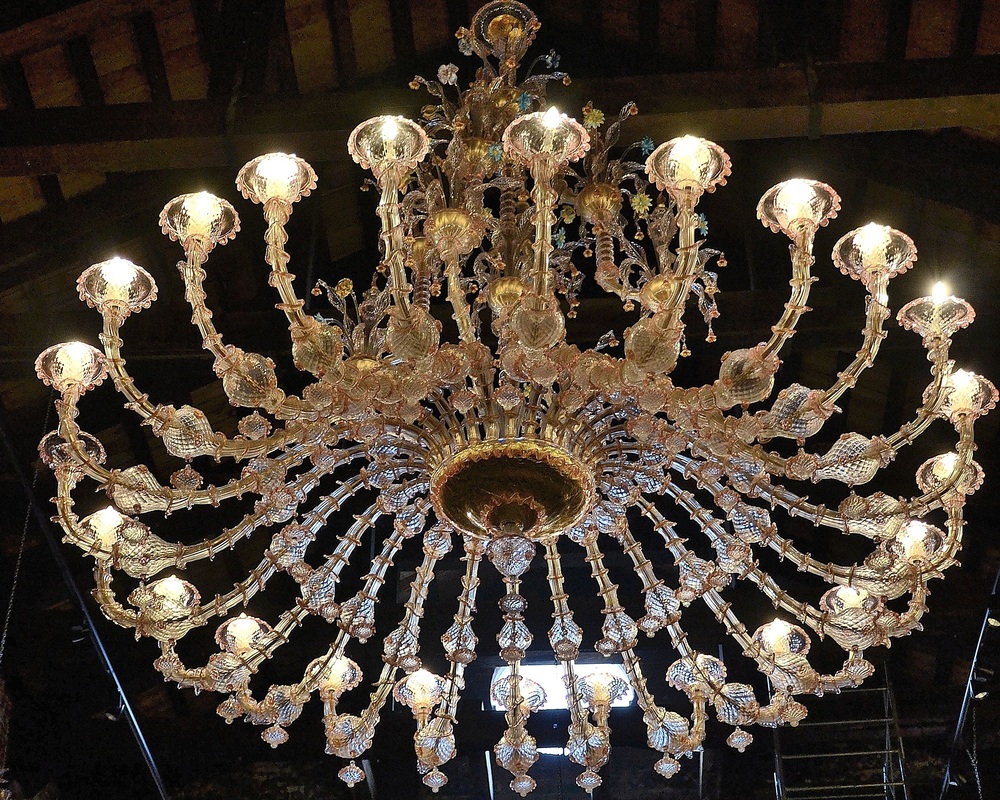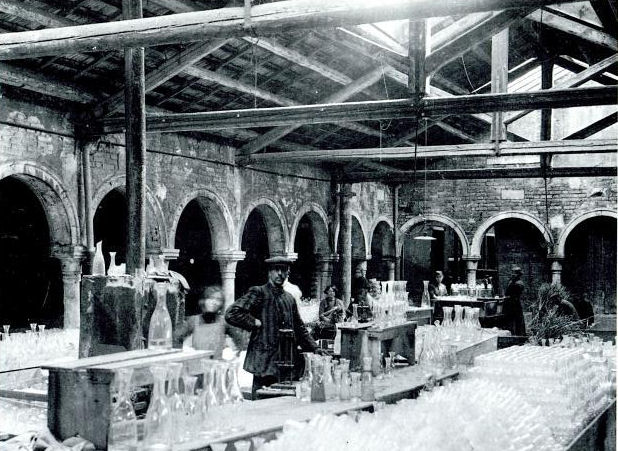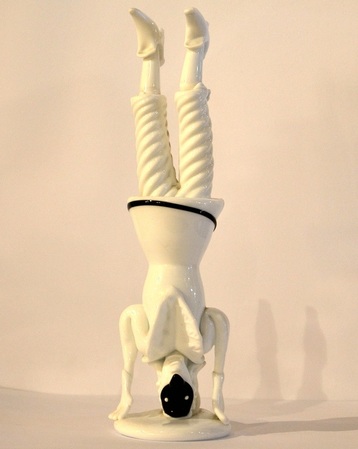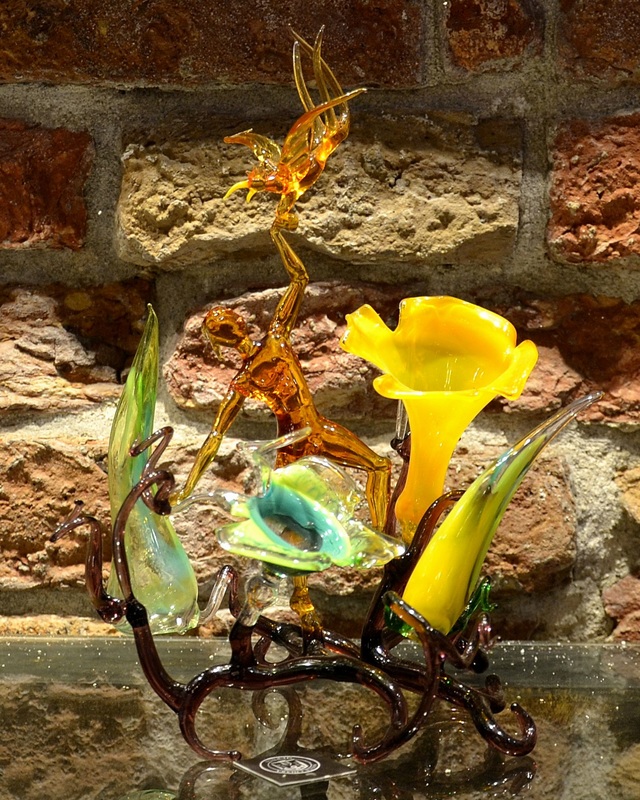History of Murano and Murano Glass
Early History of Murano Island: |
Murano, like many islands in the northern lagoon, was settled by Romans fleeing the fall of the Roman Empire and the Barbarian invasions of the late 5th century. While there is evidence of glass production in the lagoon from as early as the 6th century, the early economic activities of Murano were centered around fishing and trade in salt. During the early years of the Republic of Venice, the territory called “Murano” encompassed the Islands of Sant'Erasmo, Vignole and San Michele. The territory of Murano had its own Grand Counsel, similar to Venice' Counsel of 10, and even minted its own currency. It was not until the year 1200 that Murano became governed by a podesta (magistrate) from Venice.
|
Venetian Glass Before Murano:
Glass work is the most ancient and important art practiced in the lagoon, and was for hundreds of years one of the most important commercial industries of the Venetian Republic. The first recorded mention of a Glass Master in Venice, bottle-maker Dominicus Phiolarius, dates from the year 982. However, archeological research suggests that glass production was practiced in the lagoon, on the island of Torcello, even before the founding of the Republic. Venice was known and commercially successful in glass production, particularly mirrors and bottles, before all of the furnaces were moved from the center of the city and concentrated on the island of Murano in the year 1291. Thoughsome furnaces already existed on Murano, there were at the time a large and growing concentration of glass workshops in Riva Alto and Dorsoduro in the center of Venice.
Who Were the Glass Workers? Why Did Glass Arts Flourish in Venice?:
Venice and the lagoon islands, from their earliest history, were settled by peoples fleeing conflict in the region. Among the first settlers were former citizens of the Roman Empire. Roman society had been producing and using glass objects domestically, religiously and decoratively since the 1st century AD. Later, immigrants from the East, primarily those fleeing the siege of Constantinople, brought with them extensive knowledge of the glass arts and production processes of the East. Thus did Venice and Murano, over several centuries and under the protection of the Republic, become a literal melting pot of international glass working techniques and the global center for advancement in both the production of glass itself and objects made of glass.
The Republic of Venice & The Glass Industry:
The government of the Republic recognized the potential importance of the burgeoning glass industry and acted to protect and develop it. Between the 11th and 12th centuries, the expanding Republic negotiated free trade agreements and established protected trading colonies throughout the Mediterranean, the Holy Land and the Orient. Trade in glass products was brisk. In the year 1271, the Counsel acted to protect the glass industry domestically by both prohibiting the importation of foreign glass into Venice and prohibiting foreign glassworkers from working within the city. Only 20 years later, all of the furnaces were ordered moved to the Island of Murano. It is often claimed that the decision to move the furnaces to Murano was intended to protect the center of Venice from the risk of fire. It is also, however, much easier to protect trade secrets when all those who know of them are concentrated on one Island in a lagoon.
Murano Island: The World's First Industrial ParkThe moving of all of the furnaces to the island of Murano in 1291 created, 500 years before the industrial revolution in Europe, the first industrial park in the world. And, whereas now-a-days Murano glass is strictly a luxury product, for the several hundreds of years Murano held a near monopoly over commercial glass production in Europe.
|
The Murano glass factories then produced both commercial and luxury glassworks side by side. The commercial production, including beads and bottles, was equally as important to the Venetian economy, and the overall development of international trade, as was trade in luxury products from Murano.
Privileges & Restrictions of Murano Glass Masters:
The forced move of the furnaces, and thus also the glass workers and their families, to Murano was accompanied by a series of both incentives and restrictions put in place by the Republic. Glass masters received an elevated social status, well above that of other craftspeople. The daughters of Glass masters were allowed to marry into Venetian Nobility. Glass masters were permitted to carry swords. And, they were immune from prosecution. These were all fine incentives not only to make the move to Murano, but also for glass masters throughout the years to encourage their children to continue working in glass. It may also have had the effect of keeping the secrets of Murano glass production even more closely guarded, not only on the Island, but also within families. On the other hand, so jealous was the Republic of the secrets of Murano glass that Glass Masters were prohibited from leaving Venice without express permission. Masters who left without permission and later returned could be banished from the guild, and hence no longer allowed to work in glass. And, the exporting of the secrets of Murano Glass production abroad was a crime punishable by death.
Murano Glass During the Renaissance & The Age of Discovery:
Amazing Murano GlassOne of the effects of concentrating the glass masters on Murano, in close proximity to one another, was an interchange of skills and ideas that quickly lead to vast expansion of glass production in Venice and massive innovations in glass working itself. The Murano glass masters made important scientific discovers related to the the production of glass. Master Angelo Barovier discovered the processes of making “Cristallo Veneziano”, the world's first truly clear glass, in the 15th century.
|
Valuable lattimo glass was created by Master Antonio de Pisa. Meanwhile, the Murano Glass Masters made continuous artistic innovations in the sculpting and decoration of glass. For example, Master Joseph Briati designed the signature Murano glass flowered chandelier, which remains to this day highly prized the world over, in the late 1600's. Thus did the Murano glass masters become and remain for hundreds of years the principle producers of luxury glass products in Europe.
During the Age of Discovery - between the early 1400's and the late 1700's - when Europeans began trading in India, Africa and the Americas, they encountered peoples who had little interest in their currency, but who placed high value on decorative objects. Murano glass beads were commissioned by merchant sailors to use in exchange for spices, ivory, palm oil, and even slaves. It is claimed that Christopher Columbus presented the Natives of San Salvador with a gift of Murano glass beads when he first landed in "The New World" in 1492. The Murano glass factories produced up to 2 million pounds of these beads per year. Such beads were known as "trade beads" and later by the more ominous name of "slave beads".
Murano Glass Seed Beads:Contrary to "trade beads", which were indisputably a product of Murano but are rarely recognized as such, tiny Murano glass "seed beads" were both instruments of international trade and symbols of wealth within Europe. Seed beads, almost as small as the head of a needle, were used in embroidery, weaving and jewelry making. The beads themselves were produced by the billions in the Murano glass Conterie factories by means of a unique process of "pulling" molten glass, invented on Murano.
|
"Pulling" the glass enabled the masters to insert the thinnest bubble of air - the hole in a bead - throughout a length of glass. Thus were they able to produce thousands of beads from one cane of glass, rather than the old process of making beads one at a time. Murano maintained a monopoly in the production of seed beads from the 1400's until the 1700's. And, seed bead production remained extremely commercially important to Murano until the 20th century.
Cristallo Veneziano: Murano Glass as Clear as CrystalThe Murano glass masters were not only artists and producers of glass objects, they were also pioneers in the science of producing glass itself. Perhaps the most important development in Murano glass-making was the discovery by Murano Glass Master Angelo Barovier in the Mid 1400's of the formula for producing the worlds first truly transparent glass, cristallo Veneziano. The impact of this discovery can not be overstated.
|
Not only was there immediate demand for glasswares such as drinking glasses, bowls and vases made of cristallo Veneziano, cristallo also paved the way for advancement in glass arts by, for example, enabling the glass masters to produce the world's first purely reflective glass mirrors.
Murano Glass Chandeliers:Through it is true that the some secrets of working Murano glass leaked out slowly over the centuries, the first real crisis of competition for the Murano glass masters came from Bohemian cold-worked crystal in the late 1600's and early 1700's. The Bohemian style of cutting or gem-faceting glass became quite popular with European nobility. However, with Bohemian glass best suited to carving, whereas Murano glass was well suited to sculpting, there was room for competition in design.
|
The Murano glass masters responded with a design that would come to represent both Murano and luxury glass throughout the ages. Murano Glass Master Giuseppe Briati is credited with the designs of both the "ciocce", the iconic Murano glass flowered chandelier, and the "rezzonico" chandelier composed of hundreds - sometimes even thousands - of individual handmade pieces.
Murano Glass After the Fall of the Republic:
|
After the Republic of Venice fell to Napoleon in 1797, Venice and Murano experienced a sharp cultural and commercial decline. Our own Ex Chiesa di Santa Chiara was deconsecrated by Napoleon; the Nuns dispersed to other religious institutions. But, the real crisis for Murano came with the fall of the Napoleonic Kingdom and the imposition of Habsburg Rule over Venice. The Habsburgs favored Bohemian crystal over Murano glass extremely and during their 20 year reign over Venice - 1815 to 1835 - they both restricted and heavily taxed the importation into Venice of the raw materials needed to make glass works.
|
Nearly half of all factories on Murano closed during the 20 years of Habsburg rule and those that remained operational were engaged in purely commercial production of items such as trade beads and glass bottles. These productions, particularly as the age of Discovery was drawing to a close and there were by that time many other centers of commercial glass production in Europe, were certainly not enough to sustain Murano nor to satisfy the creativity of the Glass Masters in the long term.
Revival: Murano Glass Art & Design in the Early 1900'sIronically, it was the luxury production of Murano Glass that was to be revived, survive and thrive while the commercial production all but vanished completely between the mid-1800's and the mid-1900's. In the 1850's two new firms, Fratteli Toso and Salviatti, were each ostensibly opened to engage in commercial glass production. But, within a decade each had switched to reviving luxury Murano glass working techniques instead. They found commercial success abroad within Europe and more new furnaces were opened including Fratelli Barovier.
|
Not long thereafter, Venice hosted her first International Arts Biennale and its fair to say that both Murano Glass masters and designers were inspired by the potential of Murano glass to be used in the creation of modern pieces. In 1921, Venini, the first Murano glass furnace focused entirely on producing Murano glass in modern designs was opened. Thereafter, many both existing and new furnaces moved from what has been called by some a purely artisnal practice of Murano glass production into the production of "design" glass - glass works created as a result of collaboration between glass masters and avant guard designers - for which Murano remained famous throughout the 20th Century.
Contemporary Murano Glass:Today, works of Murano glass, be they small blown glass jewelry or large intricate chandeliers, remain highly desired luxury products. The glass masters of Murano continue to produce myriad types of glass works from the classic styles designed by their forefathers during the Renaissance to the clean lines of design-era pieces, to the bold contemporary lampworked sculptures of artists like Igor Balbi and Massimiliano Calderone. The commercial production of utilitarian objects, such as bottles, which can be easily and cheaply mass-produced elsewhere, is no longer practiced on Murano. Instead, Murano today is a literal melting pot where the skills and techniques developed by the masters over nearly 900 years are combined with contemporary artistic vision - and of course ever evolving public tastes - to create ever newer and more beautiful designs in Murano glass.
|
In Contemporary times, Murano glass and the Murano glass masters face the new commercial threat of mass produced glass made to imitate some of the most famous forms and styles of glass work invented by the Murano glass masters in the past. As these pieces are cheaply produced, they are also sold more cheaply than authentic Murano glass. However, as they did when faced with the challenge from Bohemian crystal during the Renaissance and again when struggling to recover from their suppression under the Habsburgs, the Murano Glass masters are once again responding to a challenge by producing more original, more unique and more beautiful works of original Murano glass.

